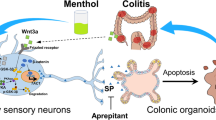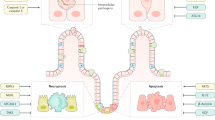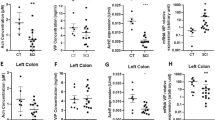Abstract
Inflammatory bowel diseases (IBDs) are chronic relapsing and remitting conditions associated with long-term gut dysfunction resulting from alterations to the enteric nervous system and a loss of enteric neurons1,2. The mechanisms underlying inflammation-induced enteric neuron death are unknown. Here using in vivo models of experimental colitis we report that inflammation causes enteric neuron death by activating a neuronal signaling complex composed of P2X7 receptors (P2X7Rs), pannexin-1 (Panx1) channels, the Asc adaptor protein and caspases. Inhibition of P2X7R, Panx1, Asc or caspase activity prevented inflammation-induced neuron cell death. Preservation of enteric neurons by inhibiting Panx1 in vivo prevented the onset of inflammation-induced colonic motor dysfunction. Panx1 expression was reduced in Crohn's disease but not ulcerative colitis. We conclude that activation of neuronal Panx1 underlies neuron death and the subsequent development of abnormal gut motility in IBD. Targeting Panx1 represents a new neuroprotective strategy to ameliorate the progression of IBD-associated dysmotility.
This is a preview of subscription content, access via your institution
Access options
Subscribe to this journal
Receive 12 print issues and online access
$209.00 per year
only $17.42 per issue
Buy this article
- Purchase on Springer Link
- Instant access to full article PDF
Prices may be subject to local taxes which are calculated during checkout




Similar content being viewed by others
References
Mawe, G.M., Strong, D.S. & Sharkey, K.A. Plasticity of enteric nerve functions in the inflamed and postinflamed gut. Neurogastroenterol. Motil. 21, 481–491 (2009).
De Giorgio, R. et al. Inflammatory neuropathies of the enteric nervous system. Gastroenterology 126, 1872–1883 (2004).
Wynn, G., Ma, B., Ruan, H.Z. & Burnstock, G. Purinergic component of mechanosensory transduction is increased in a rat model of colitis. Am. J. Physiol. Gastrointest. Liver Physiol. 287, G647–G657 (2004).
Lomax, A.E., Mawe, G.M. & Sharkey, K.A. Synaptic facilitation and enhanced neuronal excitability in the submucosal plexus during experimental colitis in guinea-pig. J. Physiol. (Lond.) 564, 863–875 (2005).
Friedman, D.J. et al. From the Cover: CD39 deletion exacerbates experimental murine colitis and human polymorphisms increase susceptibility to inflammatory bowel disease. Proc. Natl. Acad. Sci. USA 106, 16788–16793 (2009).
Rybaczyk, L. et al. New bioinformatics approach to analyze gene expressions and signaling pathways reveals unique purine gene dysregulation profiles that distinguish between CD and UC. Inflamm. Bowel Dis. 15, 971–984 (2009).
Yiangou, Y. et al. ATP-gated ion channel P2X3 is increased in human inflammatory bowel disease. Neurogastroenterol. Motil. 13, 365–369 (2001).
Guzman, J. et al. ADOA3R as a therapeutic target in experimental colitis: proof by validated high-density oligonucleotide microarray analysis. Inflamm. Bowel Dis. 12, 766–789 (2006).
Atarashi, K. et al. ATP drives lamina propria TH17 cell differentiation. Nature 455, 808–812 (2008).
Wang, X. et al. P2X7 receptor inhibition improves recovery after spinal cord injury. Nat. Med. 10, 821–827 (2004).
Lazarowski, E.R., Boucher, R.C. & Harden, T.K. Constitutive release of ATP and evidence for major contribution of ecto-nucleotide pyrophosphatase and nucleoside diphosphokinase to extracellular nucleotide concentrations. J. Biol. Chem. 275, 31061–31068 (2000).
Sperlágh, B., Vizi, E.S., Wirkner, K. & Illes, P. P2X7 receptors in the nervous system. Prog. Neurobiol. 78, 327–346 (2006).
Cavaliere, F., Amadio, S., Sancesario, G., Bernardi, G. & Volonte, C. Synaptic P2X7 and oxygen/glucose deprivation in organotypic hippocampal cultures. J. Cereb. Blood Flow Metab. 24, 392–398 (2004).
Hu, H. et al. Stimulation of the P2X7 receptor kills rat retinal ganglion cells in vivo. Exp. Eye Res. 91, 425–432 (2010).
Zhang, X., Zhang, M., Laties, A.M. & Mitchell, C.H. Stimulation of P2X7 receptors elevates Ca2+ and kills retinal ganglion cells. Invest. Ophthalmol. Vis. Sci. 46, 2183–2191 (2005).
Linden, D.R. et al. Indiscriminate loss of myenteric neurones in the TNBS-inflamed guinea-pig distal colon. Neurogastroenterol. Motil. 17, 751–760 (2005).
Locovei, S., Scemes, E., Qiu, F., Spray, D.C. & Dahl, G. Pannexin1 is part of the pore forming unit of the P2X7 receptor death complex. FEBS Lett. 581, 483–488 (2007).
Seminario-Vidal, L. et al. Rho signaling regulates pannexin 1–mediated ATP release from airway epithelia. J. Biol. Chem. 286, 26277–26286 (2011).
Thompson, R.J. et al. Activation of pannexin-1 hemichannels augments aberrant bursting in the hippocampus. Science 322, 1555–1559 (2008).
Ferrari, D. et al. P2Z purinoreceptor ligation induces activation of caspases with distinct roles in apoptotic and necrotic alterations of cell death. FEBS Lett. 447, 71–75 (1999).
Ferrari, D. et al. Extracellular ATP triggers IL-1β release by activating the purinergic P2Z receptor of human macrophages. J. Immunol. 159, 1451–1458 (1997).
Silverman, W., Locovei, S. & Dahl, G. Probenecid, a gout remedy, inhibits pannexin 1 channels. Am. J. Physiol. Cell Physiol. 295, C761–C767 (2008).
Silverman, W.R. et al. The pannexin 1 channel activates the inflammasome in neurons and astrocytes. J. Biol. Chem. 284, 18143–18151 (2009).
Chekeni, F.B. et al. Pannexin 1 channels mediate 'find-me' signal release and membrane permeability during apoptosis. Nature 467, 863–867 (2010).
Gulbransen, B.D. & Sharkey, K.A. Purinergic neuron-to-glia signaling in the enteric nervous system. Gastroenterology 136, 1349–1358 (2009).
Gomes, P. et al. ATP-dependent paracrine communication between enteric neurons and glia in a primary cell culture derived from embryonic mice. Neurogastroenterol. Motil. 21, 870–e62 (2009).
Collins, S.M. The immunomodulation of enteric neuromuscular function: implications for motility and inflammatory disorders. Gastroenterology 111, 1683–1699 (1996).
Vasina, V. et al. Enteric neuroplasticity evoked by inflammation. Auton. Neurosci. 126–127, 264–272 (2006).
Krauter, E.M. et al. Changes in colonic motility and the electrophysiological properties of myenteric neurons persist following recovery from trinitrobenzene sulfonic acid colitis in the guinea pig. Neurogastroenterol. Motil. 19, 990–1000 (2007).
Bossone, C., Hosseini, J.M., Pineiro-Carrero, V. & Shea-Donohue, T. Alterations in spontaneous contractions in vitro after repeated inflammation of rat distal colon. Am. J. Physiol. Gastrointest. Liver Physiol. 280, G949–G957 (2001).
Mizuta, Y., Isomoto, H. & Takahashi, T. Impaired nitrergic innervation in rat colitis induced by dextran sulfate sodium. Gastroenterology 118, 714–723 (2000).
Depoortere, I., Thijs, T. & Peeters, T.L. Generalized loss of inhibitory innervation reverses serotonergic inhibition into excitation in a rabbit model of TNBS-colitis. Br. J. Pharmacol. 135, 2011–2019 (2002).
Strong, D.S. et al. Purinergic neuromuscular transmission is selectively attenuated in ulcerated regions of inflamed guinea pig distal colon. J. Physiol. (Lond.) 588, 847–859 (2010).
McCafferty, D.M. et al. Spontaneously developing chronic colitis in IL-10/iNOS double-deficient mice. Am. J. Physiol. Gastrointest. Liver Physiol. 279, G90–G99 (2000).
Wirtz, S., Neufert, C., Weigmann, B. & Neurath, M.F. Chemically induced mouse models of intestinal inflammation. Nat. Protoc. 2, 541–546 (2007).
Storr, M.A. et al. Activation of the cannabinoid 2 receptor (CB2) protects against experimental colitis. Inflamm. Bowel Dis. 15, 1678–1685 (2009).
Gulbransen, B.D., Bains, J.S. & Sharkey, K.A. Enteric glia are targets of the sympathetic innervation of the myenteric plexus in the guinea pig distal colon. J. Neurosci. 30, 6801–6809 (2010).
Nasser, Y. et al. Role of enteric glia in intestinal physiology: effects of the gliotoxin fluorocitrate on motor and secretory function. Am. J. Physiol. Gastrointest. Liver Physiol. 291, G912–G927 (2006).
Acknowledgements
This work was supported by grants from the Canadian Institutes of Health Research (CIHR, to K.A.S., R.J.T. and D.M.M.), the Crohn's & Colitis Foundation of Canada (CCFC to D.M.M.) and US National Institutes of Health grant DK62267 (to G.M.M.). Some of the equipment used in the study was provided by funds from the Canadian Foundation for Innovation and the Alberta Science and Research Authority. B.D.G. holds fellowships from the Canadian Association of Gastroenterology/CIHR and Alberta Innovates-Health Solutions (AI-HS)/CCFC. K.A.S. is an AI-HS Medical Scientist and holds the CCFC Chair in IBD Research at the University of Calgary. R.J.T. is an AI-HS Scholar. P.L.B. is supported by AI-HS, CIHR and CCFC. J.A.M. is an AI-HS Senior Scholar and Canada Research Chair. D.M.M. is an AI-HS Scientist and holds a Canada Research Chair (Tier 1). S.A.H. holds fellowships from CIHR and AI-HS. We thank C. MacNaughton, W. Ho and A. Wang for technical support, D.M. McCafferty (University of Calgary) for providing Il10−/− mice, V. Dixit (Genentech) and J. Tschopp (University of Lausanne) for providing male Pycard−/− and Nlrp3–/– mice, respectively, N. Hyman (University of Vermont), O. Bathe (University of Calgary) and the IBD Tissue Bank for providing human tissue samples and J. Bains for reviewing and commenting on the manuscript.
Author information
Authors and Affiliations
Contributions
Overall project design and hypotheses were developed by B.D.G. under the supervision of R.J.T. and K.A.S. B.D.G. coordinated the project, conducted all experiments unless otherwise noted, analyzed the data, prepared figures and wrote the manuscript. M.B. carried out the colon contractility experiments. P.L.B., X.G., S.A.H., J.A.R., J.A.M., D.A.M., D.M.M. and G.M.M. contributed to experimental design and prepared and provided mice, tissues and reagents. All authors participated in revising the manuscript and agreed to the final version. R.J.T. and K.A.S. supervised the overall project.
Corresponding authors
Ethics declarations
Competing interests
The authors declare no competing financial interests.
Supplementary information
Supplementary Text and Figures
Supplementary Figures 1–7, Supplementary Table 1 and Supplementary Methods (PDF 83820 kb)
Supplementary Video 1
A myenteric ganglia containing enteric neurons and glia (loaded with the Ca2+ indicator Fluo4) is challenged with the P2X7R agonist BzATP. Note how the response begins in neurons, followed closely by glia. (AVI 1205 kb)
Rights and permissions
About this article
Cite this article
Gulbransen, B., Bashashati, M., Hirota, S. et al. Activation of neuronal P2X7 receptor–pannexin-1 mediates death of enteric neurons during colitis. Nat Med 18, 600–604 (2012). https://doi.org/10.1038/nm.2679
Received:
Accepted:
Published:
Issue Date:
DOI: https://doi.org/10.1038/nm.2679
This article is cited by
-
Activation of Intra-nodose Ganglion P2X7 Receptors Elicit Increases in Neuronal Activity
Cellular and Molecular Neurobiology (2023)
-
Effects of experimental ulcerative colitis on myenteric neurons in P2X7-knockout mice
Histochemistry and Cell Biology (2023)
-
Progress in the relationship between P2X7R and colorectal cancer
Molecular Biology Reports (2023)
-
Enteric neuroimmune interactions coordinate intestinal responses in health and disease
Mucosal Immunology (2022)
-
Intrauterine exposure to oxidative stress induces caspase-1-dependent enteric nerve cell pyroptosis
Pediatric Surgery International (2022)



